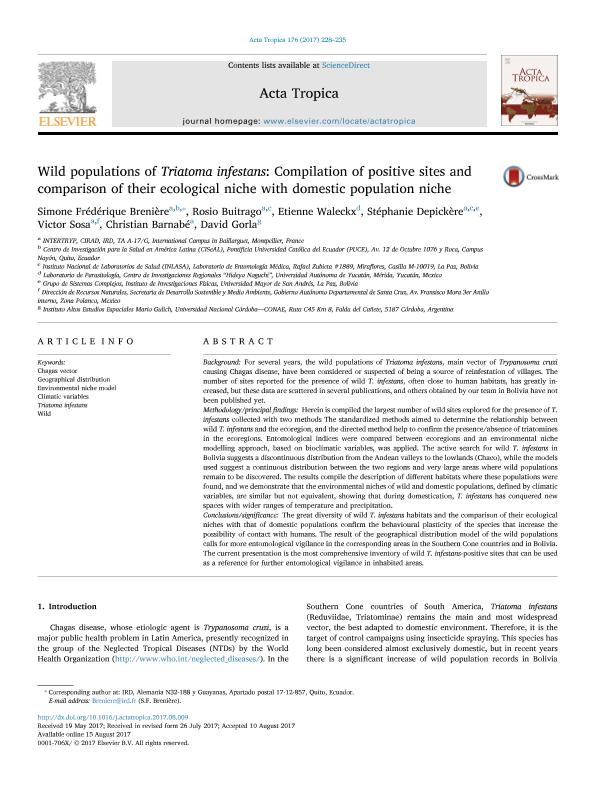Mostrar el registro sencillo del ítem
dc.contributor.author
Brenière, Simone Frédérique

dc.contributor.author
Buitrago, Rosio
dc.contributor.author
Waleckx, Etienne
dc.contributor.author
Depickère, Stéphanie
dc.contributor.author
Sosa, Victor
dc.contributor.author
Barnabé, Christian

dc.contributor.author
Gorla, David Eladio

dc.date.available
2018-04-09T20:10:11Z
dc.date.issued
2017-12
dc.identifier.citation
Brenière, Simone Frédérique; Buitrago, Rosio; Waleckx, Etienne; Depickère, Stéphanie; Sosa, Victor; et al.; Wild populations of Triatoma infestans: Compilation of positive sites and comparison of their ecological niche with domestic population niche; Elsevier Science; Acta Tropica; 176; 12-2017; 228-235
dc.identifier.issn
0001-706X
dc.identifier.uri
http://hdl.handle.net/11336/41418
dc.description.abstract
Background: For several years, the wild populations of Triatoma infestans, main vector of Trypanosoma cruzi causing Chagas disease, have been considered or suspected of being a source of reinfestation of villages. The number of sites reported for the presence of wild T. infestans, often close to human habitats, has greatly increased, but these data are scattered in several publications, and others obtained by our team in Bolivia have not been published yet. Methodology/principal findings: Herein is compiled the largest number of wild sites explored for the presence of T. infestans collected with two methods The standardized methods aimed to determine the relationship between wild T. infestans and the ecoregion, and the directed method help to confirm the presence/absence of triatomines in the ecoregions. Entomological indices were compared between ecoregions and an environmental niche modelling approach, based on bioclimatic variables, was applied. The active search for wild T. infestans in Bolivia suggests a discontinuous distribution from the Andean valleys to the lowlands (Chaco), while the models used suggest a continuous distribution between the two regions and very large areas where wild populations remain to be discovered. The results compile the description of different habitats where these populations were found, and we demonstrate that the environmental niches of wild and domestic populations, defined by climatic variables, are similar but not equivalent, showing that during domestication, T. infestans has conquered new spaces with wider ranges of temperature and precipitation. Conclusions/significance: The great diversity of wild T. infestans habitats and the comparison of their ecological niches with that of domestic populations confirm the behavioural plasticity of the species that increase the possibility of contact with humans. The result of the geographical distribution model of the wild populations calls for more entomological vigilance in the corresponding areas in the Southern Cone countries and in Bolivia. The current presentation is the most comprehensive inventory of wild T. infestans-positive sites that can be used as a reference for further entomological vigilance in inhabited areas.
dc.format
application/pdf
dc.language.iso
eng
dc.publisher
Elsevier Science

dc.rights
info:eu-repo/semantics/openAccess
dc.rights.uri
https://creativecommons.org/licenses/by-nc-nd/2.5/ar/
dc.subject
Chagas Vector
dc.subject
Climatic Variables
dc.subject
Environmental Niche Model
dc.subject
Geographical Distribution
dc.subject
Triatoma Infestans
dc.subject
Wild
dc.subject.classification
Otras Ciencias Biológicas

dc.subject.classification
Ciencias Biológicas

dc.subject.classification
CIENCIAS NATURALES Y EXACTAS

dc.title
Wild populations of Triatoma infestans: Compilation of positive sites and comparison of their ecological niche with domestic population niche
dc.type
info:eu-repo/semantics/article
dc.type
info:ar-repo/semantics/artículo
dc.type
info:eu-repo/semantics/publishedVersion
dc.date.updated
2018-04-09T15:04:34Z
dc.journal.volume
176
dc.journal.pagination
228-235
dc.journal.pais
Países Bajos

dc.journal.ciudad
Amsterdam
dc.description.fil
Fil: Brenière, Simone Frédérique. Pontificia Universidad Catolica del Ecuador; Ecuador. INTERTRYP - Cirad; Francia
dc.description.fil
Fil: Buitrago, Rosio. INTERTRYP - Cirad; Francia. Instituto Nacional de Laboratorios de Salud; Bolivia
dc.description.fil
Fil: Waleckx, Etienne. Universidad Autónoma de Yucatán; México
dc.description.fil
Fil: Depickère, Stéphanie. INTERTRYP - Cirad; Francia. Instituto Nacional de Laboratorios de Salud; Bolivia. Universidad Mayor de San Andrés; Bolivia
dc.description.fil
Fil: Sosa, Victor. INTERTRYP - Cirad; Francia. Gobierno Autónomo Departamental de Santa Cruz. Dirección de Recursos Naturales. Secretaria de Desarrollo Sostenible y Medio Ambiente; Bolivia
dc.description.fil
Fil: Barnabé, Christian. INTERTRYP - Cirad; Francia
dc.description.fil
Fil: Gorla, David Eladio. Comision Nacional de Actividades Espaciales. Instituto de Altos Estudios Espaciales "Mario Gulich"; Argentina. Consejo Nacional de Investigaciones Científicas y Técnicas; Argentina
dc.journal.title
Acta Tropica

dc.relation.alternativeid
info:eu-repo/semantics/altIdentifier/doi/http://dx.doi.org/10.1016/j.actatropica.2017.08.009
dc.relation.alternativeid
info:eu-repo/semantics/altIdentifier/url/https://www.sciencedirect.com/science/article/pii/S0001706X17305910
Archivos asociados
